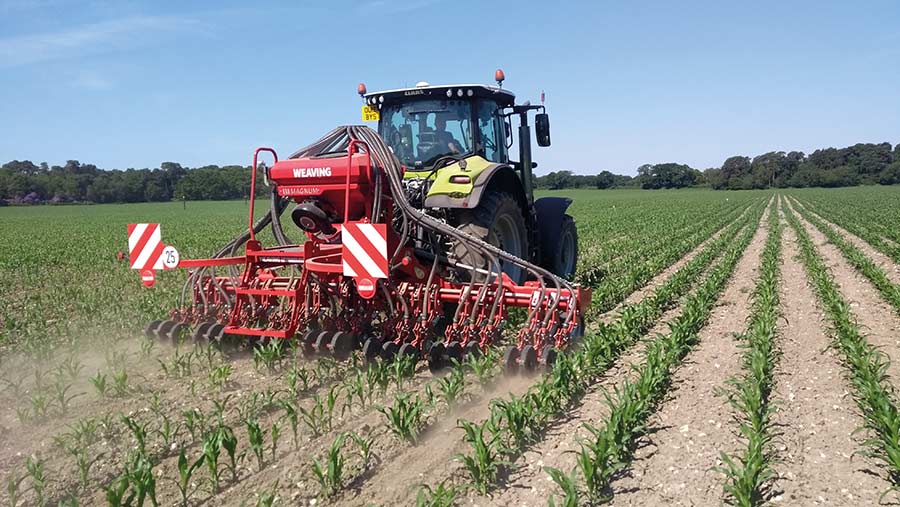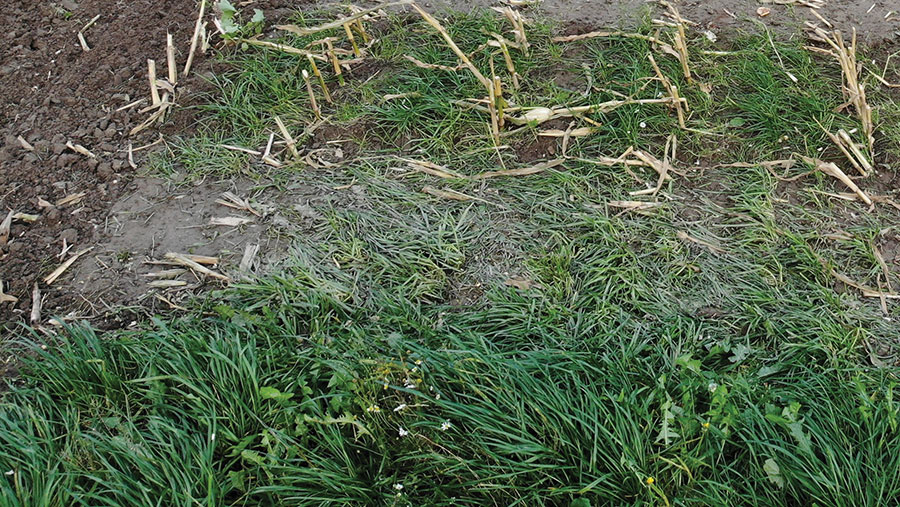How undersowing maize with grass can cut N leaching
 © Bright Maize
© Bright Maize Nitrogen (N) leaching can be reduced by 61% – the equivalent of 20kg of N/ha – when maize is undersown with grass, a recent trial has demonstrated.
Bright Maize, in collaboration with Wessex Water, carried out trials last year at its demonstration site, Dean Lanes Farm, in Wiltshire, to examine if undersown ryegrass mixes could help reduce run-off and improve N-fixation.
The challenges presented by a very wet 2019 maize harvest prompted many growers to look at undersowing their crops, especially in high-risk fields with heavy soils and sloping ground. This practice is being actively encouraged by water companies in their catchment areas.
See also: Step-by-step guide to planting maize
About the trial
Long-term and short-term Italian ryegrass mixes were drilled into standing maize plots at 20kg/ha (8kg/acre) on 26 June, four-and-a-half weeks after the maize was established (at the eight-leaf stage).
The plots were drilled by Shaftesbury-based contractor George Fraser using a purpose-built Weaving inter-row drill. The drill has a double-disc opener followed by rubber press wheels, which provide good seed-to-soil contact, he says.
“This led to an even emergence of grass across all of the different soil types we have used it on,” adds Mr Fraser, who has seen demand for undersowing increase markedly in the South West.
Pre-emergence herbicide was applied after drilling on 23 May at 3 litres/ha (1.2 litres/acre), and ammonium nitrate was applied in two doses – the first before drilling at 200kg/ha (80kg/acre) and the second on 15 June at the same rate.
Advice for undersowing maize with grass
- Variety selection When undersowing is carried out early – at the time of drilling – less-aggressive species of grass such as tall fescue should be used, but when undersowing is carried out later – four to five weeks after drilling, at the eight-leaf stage – a faster-growing Italian ryegrass is preferable
- Drilling Undersow at the six- to eight-leaf stage – typically in June – to ensure sufficient light is available for grass to grow, but late enough for the light to limit growth so grass does not impede the maize crop
- Must use an inter-row drill so the maize plant is left undisturbed
- Grass must be sown at least 15cm from the maize seed so it doesn’t compete with the maize crop
- If drilling into a standing crop at about the eight-leaf stage, put the seed under the surface – this gives the most consistent results
- Sowing rates 15-20kg/ha for ryegrass
Source: Bright Maize technical specialist Rod Crossley
Results
The maize was harvested on 17 October and undersown plots grew more grass – between 1.8t and 4.9t dry matter (DM)/ha – by the following spring, compared with grass plots alone.
On average, maize plots yielded 45t freshweight/ha at 32% DM.
Benefits

© Bright Maize
There are many benefits to undersowing crops, says Bright Maize technical specialist Rod Crossley.
As well as permitting machinery to travel on the land sooner in comparison with maize stubble, it radically reduces the risk of N run-off into watercourses, which could cost farmers thousands of pounds in cross-compliance fines.
Based on figures from the trial, 20kg of N/ha costs about £10, so big savings can be made and more N can be captured and used by the plants, he says.
By being allowed to classify undersown maize as grass, a mixed farm is also able to use more nitrogen.
Mr Crossley explains: “Overall farm N applications are restricted to a maximum of 170kg/ha as a farm average.”
However, if at least 80% of the farmed land is in grass, the maximum overall N application rate rises to 250kg/ha (101kg/acre).
“This is mainly because the economic response of N is far higher for grass than cereals or most other crops.”
Benefits of undersowing maize
- Reduces run-off and soil erosion
- Protects waterways
- Helps improve soil structure
- Retains N for the following crop
- Harvesting machinery travels better on a crop
- Plants already established after harvest will soak up any slurry applied, and equipment will travel better
- It is easier to establish a cash crop such as winter wheat if the opportunity arises – for example, it allows for one spray with glyphosate, and for wheat to be drilled straight in across rows; dead grass will still have a very good soil-binding effect, as well as improving water infiltration
Costs and return on investment
Undersowing grass typically costs about £100/ha (£50/ha for grass seed and another £50/ha for drilling), but some water companies are now offering grants of £60-£133/ha to help farmers cover the cost.
One such company is Wessex Water. It would like to see more farmers managing maize so that soils are not left bare over the winter, to help improve water quality.
Wessex Water catchment adviser Tim Stephens says: “Where no following crop like wheat or a new grass ley is planned, we actively encourage maize growers to establish a cover crop. Post-maize harvest cover crop establishment can work well after an early harvest, but in wet years, getting the grass established in midsummer gives it a better chance of retaining nutrients and preventing soil erosion the following winter.
“We are supporting farmers in our priority catchments across the Wessex region by offering them practical advice and, in some cases, financial assistance with the cost of undersowing,” adds Mr Stephens.
Grants available through water companies for undersowing maize
- South Staffordshire water provides grants of up to £150/ha through its Spring environmental protection scheme. For more detail contact Nina Yiannoukos-Benton, senior catchment adviser, 07341734293, [email protected] or visit The South Staffordshire Water website
- United Utilities offers grants of £114/ha for undersowing maize and cover cropping in the Cheshire groundwater safeguard zones and on the Llangollen Canal. The grant application window is typically from April to mid-May. Farmers can get in touch via [email protected]
- Severn Trent provides grants through its Steps environmental protection scheme. Applications are open now until 31 January 2022. For more information, find your local agricultural adviser at the Severn Trent website
- For more information on the Wessex Water grants, contact [email protected]
- South East water offers funding for growers looking to undersow their maize. There are several offers including £160/ha for inter-row sowing at or post establishment. Email [email protected] and put “Maize” in the subject line
